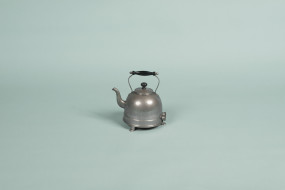Forgotten objects that were once ubiquitous come to life when picked up and tell their stories in Everyday Relics, a new exhibition at the Museum of Science & Industry (MOSI) which opens this week.
Artists Lucy and Barney Heywood, a brother and sister team have used the latest interactive technology to celebrate the stories of ordinary items, from a discarded oyster shell in a railway station, to the symbolic solidarity of a milk bottle during the 1984 Miners’ Strike,or the once-common sound of clogs on cobbles at the start of a morning shift.
The exhibition marks a shift from traditional museum exhibitions, as the museum will be urging visitors to ‘Please Touch’ the eighteen historic objects linked to its collection that are, or were at one time ‘everyday’. When the items are picked up recorded oral histories, animations and photographs are activated by the innovative touch technology normally associated with library swipe cards or the Oyster Card.
Among the relics on offer are oyster shell which will transport you back to the 1830s, when oysters were a regular commodity loaded into the goods warehouse at Liverpool Road station, now the MOSI site,which was at the heart of the industrial revolution and part of the first passenger railway. Curator Meg McHugh explains how oysters were once common food in Britain and the shell was probably the remains of a railway worker’s lunch.
the relics on offer are oyster shell which will transport you back to the 1830s, when oysters were a regular commodity loaded into the goods warehouse at Liverpool Road station, now the MOSI site,which was at the heart of the industrial revolution and part of the first passenger railway. Curator Meg McHugh explains how oysters were once common food in Britain and the shell was probably the remains of a railway worker’s lunch.
There is a Choose a 7” vinyl record of Gary Clail’s ‘Human Nature’ and Hacienda DJ Dave Haslam takes you back to the Manchester club scene in the 1980s and a piece of African fabric from MOSI’s archive is brought to life with film footage in Africa while the voices of Margaret Hickson and Anne Mason explain the meaning of the striking pattern, which was manufactured in Manchester according to local tribal designs.
The artists donated one of their own family relics to the exhibition, a small cash tin dating back to the mid 19th across the table as an interview with their father explains that the cash tin belonged to their ancestors who ran a bank in Manchester back in the nineteenth Century. When the tin is chosen, a family tree spreads .
When a milk bottle is picked up and placed on the exhibition table it lights up an interview with milkman George Cotton and his wife Shirley, who explain that they always delivered free milk to the miners during the 1984 strike. As a result of the strike milk deliveries changed from seven to six days a week, which remained even after the strike finished.
Lucy Heywood said: “The objects in this exhibition are a tangible link with the past that visitors can hold in their hands. By using new technology we have been able to reveal their stories to help people explore MOSI’s collection in a surprising and sensitive way.”
The exhibition runs from 22 November to 29 June in the Highlights Gallery at Manchester’s Museum of Science and Industry.,







